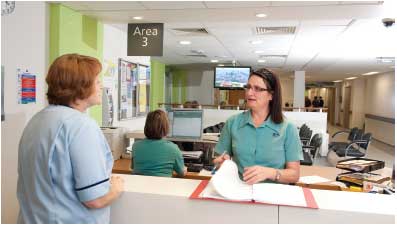Safe and Well at Work: Occupational Health and Safety Strategic Framework for NHSScotland
This person centred strategic framework sets out how NHSScotland Boards should approach occupational health and safety to keep staff motivated and healthy, engaged and safe. It provides a national statement of aims and priorities, together with a clear framework for delivering improvements in the occupational health and safety of NHSScotland staff.
Chapter 1: Introduction and Context
Introduction
1.1. Early in 2010, the Cabinet Secretary for Health and Wellbeing invited the newly-established Occupational Health and Safety Strategic Forum ( OHSSFor) to develop a new Occupational Health and Safety Strategic Framework for NHSScotland to build upon the previous strategy, "Towards a Safer Healthier Workplace", 1 published in 1999. In the period since the publication of the previous strategy, there have been many developments both within NHSScotland and in broader occupational health and safety policy.
1.2. Within NHSScotland, these include the governance framework, including Staff Governance, the Scottish Patient Safety Programme, A Force for Improvement2 and, more recently, the Healthcare Quality Strategy for NHSScotland3. More widely, developments such as Health Works and the findings of Dame Carol Black's review of the health of the working age population 4, and the NHS Health and Wellbeing Review carried out by Dr Steve Boorman 5 need to be taken into account in developing a new way forward. At the same time, employers continue to have statutory duties and responsibilities under existing health and safety and employment legislation, and across NHSScotland, staff continue to be injured or made ill by work. Against this background, it is clear that a new framework for occupational health, safety and wellbeing within NHSScotland is required.
 1.3. This strategic framework takes a person-centred approach towards the health, wellbeing and safety at work of NHSScotland staff. Such an approach is good business practice for NHSScotland and good for staff. Through keeping people motivated and healthy, engaged and safe, NHSScotland will benefit from better clinical outcomes and patient experiences, a more effective and productive workforce, and improved partnership and staff relations. The workforce will benefit personally from improved health and wellbeing, a more rewarding employee experience, and a safer working environment.
1.3. This strategic framework takes a person-centred approach towards the health, wellbeing and safety at work of NHSScotland staff. Such an approach is good business practice for NHSScotland and good for staff. Through keeping people motivated and healthy, engaged and safe, NHSScotland will benefit from better clinical outcomes and patient experiences, a more effective and productive workforce, and improved partnership and staff relations. The workforce will benefit personally from improved health and wellbeing, a more rewarding employee experience, and a safer working environment.
1.4. For the purposes of this document, occupational health and safety within NHSScotland is defined as follows:
"NHSScotland employers' responsibility for the health, safety and wellbeing of their employees, and those under training in the NHS. It encompasses line management responsibilities and systems for health and safety, including the statutory duties placed on NHSScotland Health Boards by the Health and Safety at Work Act, as well as the occupational health and safety support and services provided to staff, and the responsibilities of all employees themselves. This aligns to the Health Board's Health Works agenda for NHS staff in its promotion of health and wellbeing, prevention of absence, and support for staff in terms of rehabilitation and return to work."
1.5. All Boards must be able to access competent and professional expertise in occupational health and safety, including the provision of advice, training, audit and specialist services. This strategic framework therefore must extend beyond organisational performance into the area of occupational health and safety services.
Approach to Occupational Health and Safety
1.6. NHSScotland Boards must ensure they have robust and effective management systems for occupational health and safety, fully integrated into general management systems, with an emphasis on risk assessment and control measures to proactively protect staff and reduce injury or illness. These management systems should not operate in a silo, but need to take account of a range of wider strategic policies which impact on the workforce at local and national level. Such policies include the Scottish Patient Safety Programme, healthcare associated infection, and regulations in relation to revalidation and remediation, as well as relevant statutory requirements, such as the Equality Act 2010, proposed Patient Rights Bill and existing health and safety and employment regulations. Moreover, this strategic framework reinforces the message that occupational health and safety is the responsibility of all managers and staff within NHSScotland, supported, where necessary, by specialist support and services. Overarching governance of each NHSScotland Board's occupational health and safety should rest at Board level as an integral element of wider governance responsibilities.
1.7. There are already strong links between staff governance and occupational health and safety through the Staff Governance Standard which states that staff will be "provided with an improved and safe working environment". The Healthcare Quality Strategy for NHSScotland further strengthens these links. It ensures that NHSScotland will be able to build on existing activities and reap the full benefits of these to develop a person-centred approach towards keeping people motivated and healthy, engaged and safe within their workplace. This will result in a better employee experience within Boards, create an empowered and flexible workforce, and ultimately deliver better quality patient care.
 1.8. This approach to the health, safety and wellbeing of staff complements and supports many of the findings and recommendations set out in the recent reports to the UK Government by Dame Carol Black and Dr. Steve Boorman. Both authors recognised the important role which the workplace plays in preventing ill-health and in promoting health and wellbeing, as well as identifying the link between staff health and wellbeing and productivity/high quality patient care. Both reports recognise that being in meaningful work improves your health. A key finding of Dame Carol Black's report is that the "concept of 'good work' is fundamental to the evidence on the positive effects of work on health for individuals and to the productivity of business."
1.8. This approach to the health, safety and wellbeing of staff complements and supports many of the findings and recommendations set out in the recent reports to the UK Government by Dame Carol Black and Dr. Steve Boorman. Both authors recognised the important role which the workplace plays in preventing ill-health and in promoting health and wellbeing, as well as identifying the link between staff health and wellbeing and productivity/high quality patient care. Both reports recognise that being in meaningful work improves your health. A key finding of Dame Carol Black's report is that the "concept of 'good work' is fundamental to the evidence on the positive effects of work on health for individuals and to the productivity of business."
1.9. The new statement of fitness to work or "fit note", builds on this approach and introduces a new way of managing certified sickness absence. The fit note allows a doctor to advise a patient that, although s/he may not be fully fit, s/he may be fit enough for some work while recovering, taking into account factors such as workplace adjustments, reduced hours or modified duties. This has implications for employers and it is important that managers can access advice and support to help them manage such situations. Staff also need to be able to access advice on the implications of being given a fit note and what their expectations and responsibilities should be.
1.10. Good occupational health and safety practice is essential to ensure that staff have a safe working environment, which benefits both staff and patients. Joint guidance by the Institute of Directors and the Health and Safety Executive on "Leading Health and Safety at Work" 6 states that "Protecting the health and safety of employees or members of the public who may be affected by your activities is an essential part of risk management and must be led by the Board. Health and safety law places duties on organisations and employers, and directors can be personally liable when these duties are breached. Members of the Board have both collective and individual responsibility for health and safety."
Summary and actions:
- NHSScotland Boards must ensure robust and effective management systems for occupational health and safety, fully integrated into general management systems, with an emphasis on risk assessment and control measures to proactively protect staff and reduce injury or illness. These management systems should not operate in a silo, but need to take account of a range of wider strategic policies which impact on the workforce at local and national level.
Policy Context
1.11. The Healthcare Quality Strategy, with the supporting workforce framework, A Force for Improvement, sets out the policy direction for Scotland. Our shared goals are:
- Staff, patients and the public are confident that their NHS is reliably and consistently safe, effective and responsive to their needs.

- Everyone working in and with NHSScotland is confident that they will be supported to do what they came into the NHS to do, and that they are valued for doing that. There will be no avoidable harm or injury to people from healthcare they receive or deliver.
- To have a shared national pride in our NHS and a recognition that it is amongst the best in the world.
1.12. The Quality Measurement Framework which enables monitoring of progress in implementing the Healthcare Quality Strategy, sets out three quality ambitions which provide the framework for this document. These are set out as follows, and are discussed in further detail later in this strategic document:
Person Centred |
Safe |
Effective |
|
|---|---|---|---|
Quality Ambitions |
Mutually beneficial partnerships between patients, their families and those delivering healthcare services which respect individual needs and values and which demonstrate compassion, continuity, clear communication and shared decision making. |
There will be no avoidable injury or harm to people from healthcare they receive, and an appropriate, clean and safe environment will be provided for the delivery of healthcare services at all times. |
The most appropriate treatments, interventions, support and services will be provided at the right time to everyone who will benefit, and wasteful or harmful variation will be eradicated. |
1.13. A Force for Improvement ( AFFI) sets out the framework to ensure a quality, sustainable workforce that can deliver shared goals for NHSScotland over the longer term. Within AFFI, Working Well is of particular relevance. This is a broad strategic concept that encompasses actions that influence the workforce culture, the engagement and commitment of staff, health and wellbeing, and staff safety. It covers the whole employee experience from initial recruitment onwards, with benefits including improved morale and levels of employee commitment and enhanced productivity. This Occupational Health and Safety Strategic Framework addresses this agenda in further detail, and supplements the Working Well programme.
1.14. As with AFFI, this strategic framework needs to take into account the increasingly global and constantly changing environment within which NHSScotland is operating. Two factors which impact heavily on NHSScotland are the changing demographic profile of Scotland's population and the Scottish, UK and global economies. It is therefore essential that the existing workforce is working well and that the focus of this framework should be on ensuring the release of resources through better use of existing resources. Given that accidents and work-related ill health have a significant cost and resource impact for NHSScotland, this approach will enable Boards to do more with less as well as ensuring that staff take responsibility for their own health and wellbeing, while also being supported to be resilient and motivated in times of organisational change.
There is a problem
Thanks for your feedback